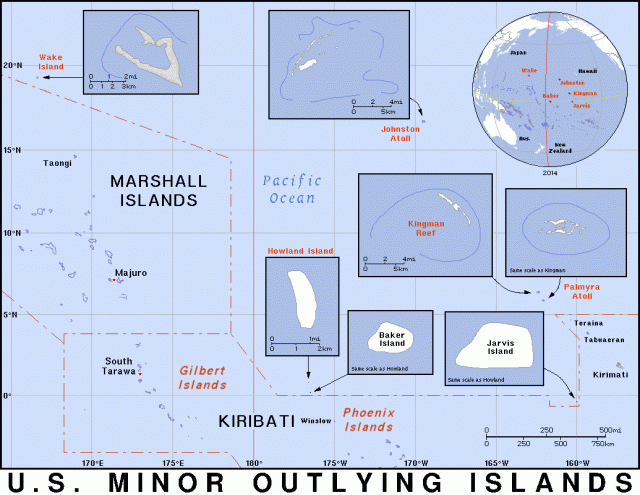U.S. Minor Outlying Islands
EIGHT TINY SPECKS of land dotting the PACIFIC OCEAN are the marks of the U.S. military presence in the region during the two major conflicts of the 20th century. The names Wake and Midway are forever linked to major air and land battles of World War II. The others are little known and are mostly maintained now as nature preserves and scientific outposts. Only Johnston Atoll had a population of any size, as the location of a chemical disposal facility, and this is in the process of closing. The U.S. Fish and Wildlife Service now administers these former outposts of U.S. military might in the Pacific.
Most of these islands are located due north of KIRIBATI and east of the MARSHALL ISLANDS. Wake is to the north of the Marshalls, and the Midway Islands are at the westernmost extremity of the Hawaiian Island chain, just about midway from CALIFORNIA to JAPAN. Palmyra and Kingman Reef are at the northern end of the Line Islands, which now belong to Kiribati. Johnston Atoll is a much further extension of this same chain but stands on its own about halfway to Hawaii. They are all low-lying coralline islands with fringing reefs. They range in climate from subtropical (Midway), to tropical (Jarvis, Johnston, and Wake), to equatorial (Baker, Howland, and Palmyra). Baker, Howland, and Jarvis are all very dry and suffer from strong winds and burning sun. Johnston is also dry. Palmyra, however, is very rainy because of the equatorial countercurrent and has much denser vegetation on its two main islands, with coconut trees and balsa-like trees up to 100 ft (30 m) tall. Nearby Kingman Reef has no permanent land, and Midway and Palmyra are mostly very flat with surrounding reefs. Wake is an atoll of three coral islands on an underwater volcano.

In the 19th century, Americans began to take interest in some of the islands of the Pacific for their deposits of guano (seabird dung), which was mined for use in fertilizers and fuels. The U.S. Guano Islands Act of 1856 established claims over a number of isolated islands, including Baker, Howland, Jarvis, and Johnston (and some of the islands now belonging to Kiribati, notably Canton and CHRISTMAS islands). Palmyra was claimed in 1862 by the Kingdom of Hawaii, and passed to the UNITED STATES with Hawaii's in 1898.
The United States annexed Midway in 1867, and Wake Island followed in 1899 for the purposes of laying the Trans-Pacific Cable, which was also laid through Midway. Guano mining ceased in the last decades of the 19th century, and most of these islands were transformed into refueling stops for journeys across the Pacific, first for ships, and then for airplanes in the 1930s. The most recent addition, Kingman Reef, was annexed in 1922 as a way station for flying boats from Hawaii to Samoa.
There were short-lived attempts to colonize Howland, Baker and Jarvis in 1935, but these islands were evacuated during World War II and never reestablished (though there is an amazingly convincing website for the fictional “Republic of Howland Baker and Jarvis” on the internet). The 20th century's most famous aviatrix, Amelia Earhart, was headed toward the refueling stations on Howland during her round-the-world flight of 1937. Her craft disappeared, however, and a beacon remains on the island to commemorate her.
Midway and Wake remained important stopover points for transpacific flights until larger airplanes made this unnecessary in the 1970s. Palmyra and Johnston (along with Christmas and Canton) became important air transport stations in World War II (Wake was occupied by the Japanese in 1941). The Battle of Midway in 1942 was a turning point of the war in the Pacific, but after the war, most military presence on these islands was shut down except for Wake, Midway, and Johnston. The last was used for high-altitude nuclear tests in the 1950s and 1960s, then converted into a storage and disposal site for chemical weapons: JACADS (Johnston Atoll Chemical Agent Disposal System), at its height of activity maintained a population of about 1,100 military and civilian personnel.
Since the 1990s, most of these islands have been transferred from the jurisdiction of the Department of Defense to the Department of the Interior's Fish and Wildlife Service. Naval operations on Midway were closed in 1993, followed by the U.S. air base on Wake (though some military contractors remain) and the gradual shutdown of the facilities on Johnston in 2000 (where about 800 people remained in early 2003). Baker, Howland, and Jarvis are a National Wildlife Refuge, home to seabirds and marine wildlife, and visited by scientists and educators. Johnston and Midway are also National Wildlife Refuges but remain mostly closed to the public—Midway is particularly attractive to tourists for wildlife observation and photography, sport fishing, snorkeling, and scuba diving (mostly from HAWAII), and it is hoped the area will reopen to the public soon. Palmyra has been privately owned by The Nature Conservancy since 2000 (purchased for $37 million to save it from becoming a nuclear waste dumpsite).